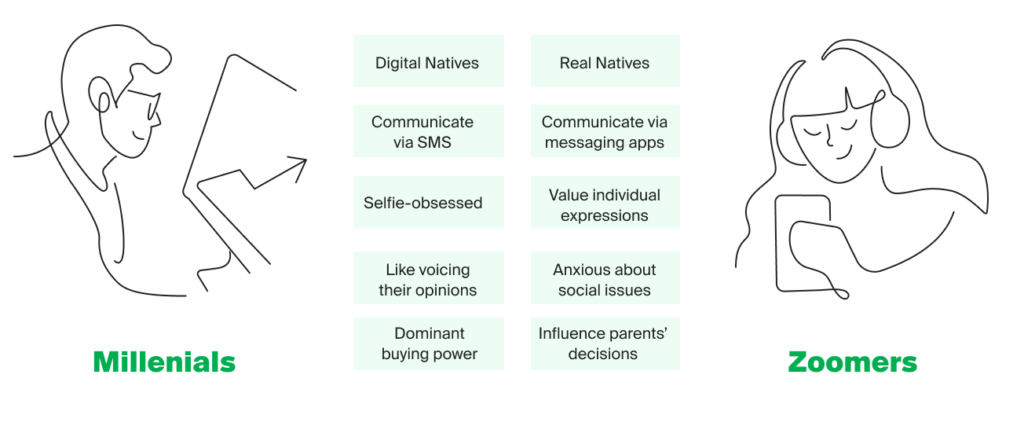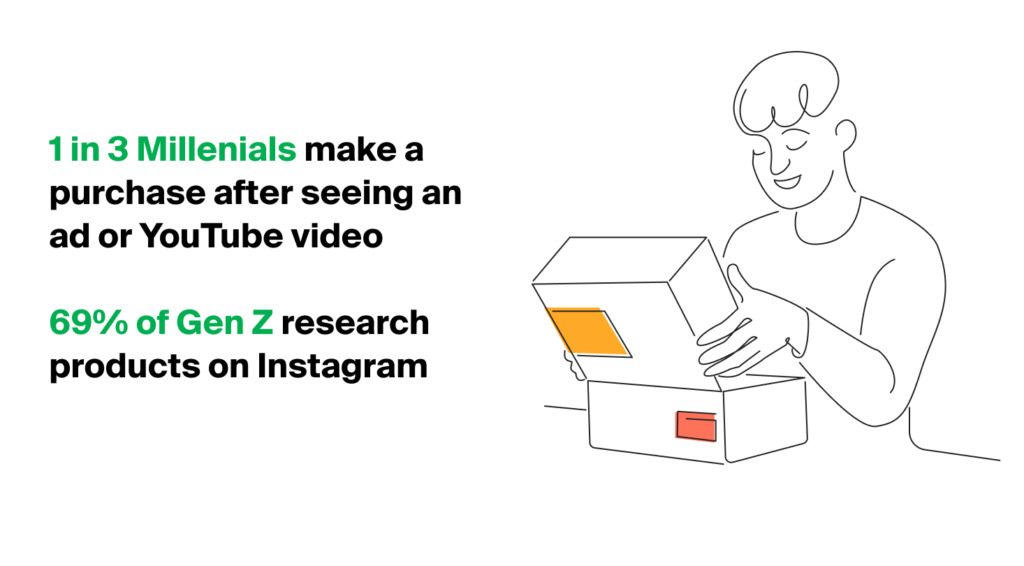Digital Natives
Born into socio-economic prosperity between 1981 and 1996, Millennials are the first digitally native generation (although purists may argue that the Internet emerged in 1983 making Gen Z the first “real” natives). Millennials are also known as “Gen Y” and have a few monikers like “me generation”, and “generation mute” due to their preference for communicating via SMS, messaging apps and social media. Their ages span from 27 to 42, which is a key demographic characteristic marketers should include in their persona development and targeting strategies.
One way to collect this piece of information is to create a birthday present initiative and program your AI chatbot to ask your consumers and prospects for their name and age to enrol them. When crafting your business messages, split test different styles, without stepping outside of your brand persona, because some prefer full, expressive sentences as opposed to slang and emojis.

Home Truths
Gen Z, or “Zoomers” were born between 1997 and 2012. According to recent stats, 1/3 of them are employed or self-employed, 51% are students and only 11% are married or have started a family. McKinsey refers to Gen Z as “true gen” because they value individual expression, authenticity and fluidity over categorisation and labels, and believe open dialogue can overcome the world’s problems.
These are important considerations for eCommerce and Retail businesses as they reveal behavioural patterns connected to the way Gen Z shops and communicates with brands. Two-way communication solutions like SMS, WhatsApp, AI chatbots and Viber conversational messages are a great way to fully engage Gen Z on a 1-2-1 basis. The current socio-political and economic climate, incessant digital sensory bombardment, an often-undefined identity, and the desire for truth and a better world have taken their toll on this young generation. 61% report feeling anxious and on edge whilst 42% are depressed – significantly higher than the older generations. It’s no wonder that 58% of Gen Z prefer funny and light-hearted online content and 52% want brand engagement via social media, advertising and business messages to be inspirational. To fully engage them, focus on mental well-being and the practical benefits and joy that products bring, over materialism.

Empathic Influencers
On the plus side, Gen Z’s search for authenticity brings freedom of expression, openness, and empathy. Conversely, 92% of Gen Z feel completely misunderstood by brands. These factors explain why 55% of them consider influencer product reviews a huge purchasing driver. Gen Z currently represent over 1/3 of all social media influencers and are the highest paid, at an average of $245 for a story, $520 for a post, and $807 for a video. Interestingly, whilst Gen Z have overtaken them as the most high-profile influencers, 44% of Millennials are still more likely to purchase from influencer recommendation over a purely branded message. eCommerce businesses targeting either Gen Y or Z should explore partnering with an influencer who genuinely embodies their brand persona, values and products and the ideals of these socially-conscious consumers.
Smarts
The popularity of reality tv and the rise of the “celebrity” has led to the mainstream media frequently portraying Millennials as vacuous and selfie-obsessed. However, eCommerce businesses shouldn’t make the same mistake if they want to engage them. Millennials are, in fact, the most educated generation in Western history. For example, 34% of Americans aged 24-29 hold a degree somewhere between bachelor to doctorate. Gen Z are set to beat this record, in part because 44% of them have at least one parent with higher education.

Buying Power
Millennials account for the largest proportion of the population and their global projected spend is $2.5 trillion. Bloomberg estimates Gen Z’s purchasing power at $360 billion. This is considerably lower than many expert projections pre-covid and the cost-of-living crisis. However, 70% of Gen Z’s parents consult them before buying everything from electronic goods and apparel to restaurants, holidays, and home décor. So, even if Gen Z aren’t your direct target market, it’s essential to factor their preferences into your marketing strategy.
Gen Z are more impulsive shoppers than Millennials, which has led to an uptick in specialised teen debit cards. They also like to get maximum value for their money and will shop around to get it, disregarding brand loyalty. Ensure you highlight that your eCommerce store accepts these cards with in-store signage, ads and text messaging, and think about ways you can affiliate with young adult card providers to provide additional value. This love of value presents upselling and cross-selling opportunities, as long as the products and bundles you suggest are useful and high quality. Ensure you chatbots and business messages showcase add-on products with carousel images and video for this visually stimulated group of consumers, along with a personalised discount code.
Brand & Product Discovery
Millennials like voicing their opinions. 40% want to be consulted about the creation of new brands and products, while 70% consider it their social responsibility to give feedback and reviews. Brands can enable this via WhatsApp and Viber surveys and polls, which creates a more controlled environment than social media, whilst boosting engagement and loyalty.
47% of Millennials use social media to discover new trends and 1/3 make a purchase after seeing an ad or YouTube video. Keep content brief as the digital attention span for a Millennial is around 12 seconds and Gen Z’s is 8! In spite of 3rd party cookies being on the way out, 72% of Millennials are fans of the personalised ad, so you’ll need to segment and target your awareness stage advertising based on available demographic data. Partner with an influencer to create a website or social media AI chatbot with a Millennial persona for a more personal touch. The chatbot is perfectly positioned to ask them questions and gain first party personal data at the earliest stage, to enable hyper-personalisation throughout the funnel. Make sure your on-site SEO is strong, as more than 50% of Millennials use search engines to discover products.
Whilst people often associate TikTok with Gen Z, research shows this generation in fact prefers Instagram. 76% of Gen Z is posting on Instagram compared to 45% for TikTok, and 69% research products on Instagram. If you want Gen Z to see your ads your best bet is to use streaming services. They are also more likely to go into your brick & mortar shop than Millennials but, overall, they still prefer digital browsing and shopping channels.

Sales Catalysts
With technology being their comfort zone, 68% of Millennial consumers demand a frictionless, integrated, omnichannel shopping experience. Reward and VIP initiatives are important to them, with 61% already belonging to a program. This contrasts with Gen Z at only 45%. Both generations are open to both cashback and points but, for convenience-focused Gen Z, a reward scheme that comprises multiple brands and offers personalised rewards is the gold standard. To boost conversions it’s essential to offer both Gen Y and Z a Buy Now Pay Later (BNPL) option as both prefer this method of payment over traditional credit. It can even increase your Average Order Value (AOV), as they’re likely to spend 18% more when they can spread the cost. Another big driver for 76% Gen Z is “convenience”. This means on-demand, speedy delivery, particularly for groceries and takeout via apps like UberEats, Deliveroo, Go Puff, and DoorDash. Remember to include these value-adds in your business messaging strategy as, catering for these preferences is a competitive differentiator.
Rebels with a Cause
Half of Gen Z want to buy from businesses that have a positive social impact on racial justice, LGBTQIA+ rights, gender equality and climate change. This compares to 41% of Millennials, who are also interested in affordable healthcare for all.
If your products and packaging are specifically geared towards these causes, ensure this is highlighted across all your channels. If your products aren’t yet centred around these values, there are other ways to incorporate them into your company culture and demonstrate your commitment. Authenticity is paramount to both Millennials and Gen Z, so launching a campaign paying lip-service to these important social issues won’t have the desired effect and will likely lead to customer churn. Remember all the brands that were publicly criticised in 2022 for “rainbow-washing” and running LGBTQIA+ campaigns during Pride Month just to gain attention?
Make sure that your corporate social responsibility and social impact goals are front and centre on your website and highlighted in your campaigns. Partner with non-profits and other businesses or create WhatsApp and Viber community groups to support these causes. Social followers see more than just your marketing campaigns so, when you’re running a talent acquisition campaign, for example, ask current employees to create honest vlogs to demonstrate your commitment to gender equality, income equality and LGBTQIA+ rights. 82% of Gen Z research a brand before making a purchase. So, if you’re not genuinely trying to make a positive difference in the world, you’ve fallen at the first hurdle in attracting “True Gen”.
What Makes them Leave a Brand?
Gen Z will switch to a competitor if an item they really want is out of stock, so ensure you’re well stocked on products going viral on Insta and TikTok. Create re-stock notification text messages along with personalised discount vouchers to apologise for the inconvenience. You can also, of course, try to cross-sell or upsell similar popular items using carousel images on WhatsApp and Viber, and links to your influencer recommendation videos via SMS.
Final Thoughts
For both Millennials and Gen Z, brand authenticity and social conscience are key, so messaging that goes against your brand persona, values and mission, or is overly-intrusive or patronising, will lead to customer churn. Whilst it’s worrying that 75% feel brands are all talk and no action, it shows there’s a gap in the market and an opportunity to shine for brands that are socially conscious authentic and consistent. Convenience, speed and diverse payment options are a no brainer. It’s also clear that, for these tech-lovers, you must meet them on their preferred channels with promotional, conversational and transactional business messaging, creating an excellent multichannel customer experience (CX).

